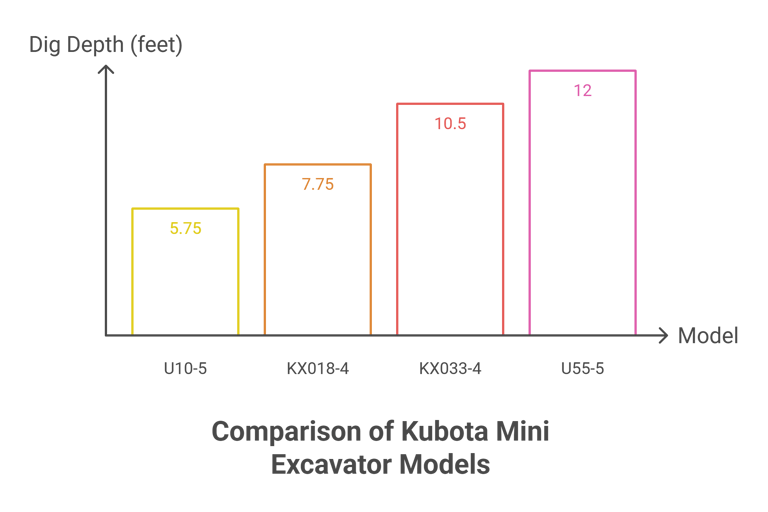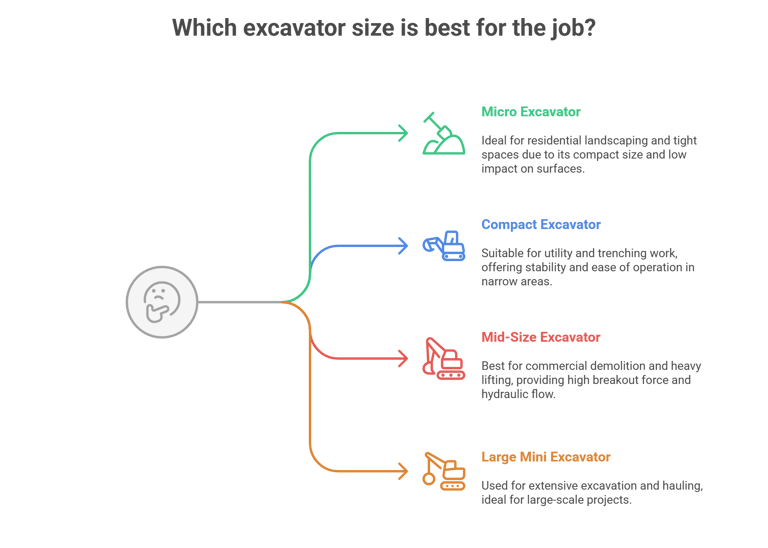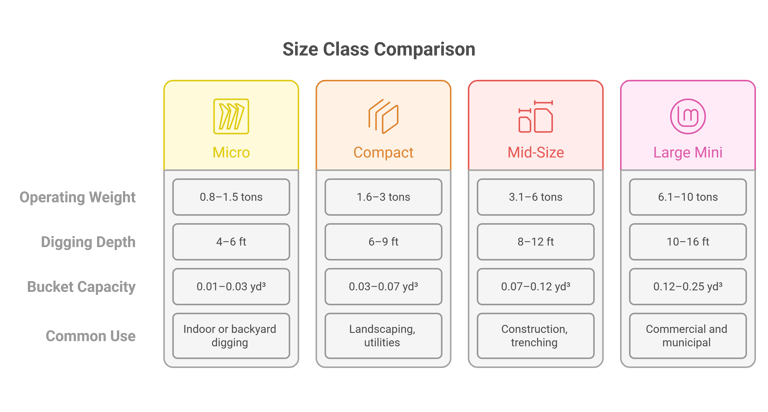Free Shipping Sitewide | 1 Year Warranty
Mini Excavator Sizes to Know: Getting the Proper Machine for Your Task
Explore key mini excavator sizes to find the right fit for your job—match machine capacity with task requirements for optimal performance.
MINI EXCAVATORS
7/27/202510 min read
Mini Excavator Sizes to Know: Getting the Proper Machine for Your Task
Introduction
Why Mini Excavator Size Matters
One of the biggest decisions to make when the need arises to buy or rent a mini excavator is the machine''s size. A wrong size means that you can either not complete your work because it is underpowered or work in a limited space and be difficult to handle because of its size.
The correct mini excavator size affects everything from how far you can cut the ground, how big a volume of material you can move, to how easy it will be for you to transport and store the machine.
So, knowing the sizes of mini-excavators is necessary not only for result, but also for security, and money-saving directly used by a professional contractor, landscaper, or just a hobbyist a DIY homeowner.
Applications That Depend on the Right Size
Mini excavators are employed in hundreds of different ways:
Trenching for utility lines
Grading driveways or small lots
Installing fence posts and landscape features
Digging foundations for small buildings
Breaking concrete or asphalt with attachments
These different works come with various demands and requirements. A machine suitable for backyard trenching may not be able to do the work of lifting heavy rocks or digging deep footers of commercial foundations.
Without doubt size selection is about matching the right machine to the job.
Overview of Sizing Categories
Mini excavators are generally classified into the following four size categories in the construction world:
Micro (0.8 to 1.5 tons)
Compact (1.6-3 tons)
Mid-Size (3.1-6 tons)
Large Mini Excavators (6.1-10 tons)
Every group has its advantages and limitations with respect to the following traits:
Digging depth
Hydraulic power
Transport requirements
Cost to own or rent
What if we explained the pros and cons of each group and guided you towards the one that best suits you?
Mini Excavator Size Categories Explained
Micro (0.8 to 1.5 Tons)
Micro models are the tiniest of the available excavators, and they are made for ultra-narrow access and low-weight jobs. As a rule, they:
Weigh less than 3,300 lbs
Fit through a standard 36” gate
Can dig up to 4-6 feet deep
Have insertable tracks for easy storage
Micro excavators are suitable for:
Backyard work
Minor trenching projects
Indoor dismantling
Rental markets that focus on DIY users
Examples of micro excavators are Bobcat E10, Kubota U10-5, and JCB 8008 CTS.
The problem? The power, the range, and the lifting capacity are very limited. Nevertheless, they are still unbeatable for small properties or extremely tight spaces.
Compact (1.6 to 3 Tons)
The class size is the most common among contractors and landscapers. Compact excavators:
Have a weight of 3,500-6,600 lbs
Offer the digging depths of 6–9 feet
Allow more safe operation
Can be used for different ranges of the equipment
On the one hand, they are capable of balancing the performance and their small size, which allows them to be the perfect match for:
Utility work
Driveway grading
Fence and deck installation
Light demolition
The models under this category are the Kubota KX018-4, CAT 301.7D, and Bobcat E20.
But these are still small enough to be towed with a half-ton truck and a trailer. Moreover, they are powerful enough to make confident digging, lifting, and carrying operations.
Medium (3.1 to 6 Tons)
Mid-size mini excavators are built for tasks that are more demanding. Machines like these:
Best of 6,600 to 13,000 lbs
Dig to 12 feet deep
The support heavier attachments like breakers and tilt buckets
Have larger cabs and more interior comfort features
They Are:
General contractors
Utility crews
Site prep professionals
Municipal workers
Some commonly known models are Takeuchi TB240, CAT 305E2, and Kubota U35-4.
In order to get them, you will need a big enough trailer (10,000+ lb rating) and a strong tow vehicle. However, they make great work and site efficiency possible.
Big Mini Excavators (6.1 to 10 Tons)
These models are also called compact excavators, and they are located right at the border of the “mini” category. They:
Have 13,000 to 22,000 lbs
Dig ranging from 13 to 16 feet
Can do a heavy lifting (depending on the weight) of over 4,000 lbs
Are usually transported with the help of CDL-level trailers
Such machines are used for:
Light commercial demolition
Roadside trenching
Foundation prep
Heavier utility jobs
These are the Bobcat E88, CAT 308 CR, and Yanmar SV100.Such machines provide the same output as full-sized ones but have a smaller footprint, nevertheless, they have higher purchase and operating costs.
Key Specifications That Define Size
Operating Weight and Transport Needs
The weight of the machine in its working condition is generally regarded as the basis of the mini excavator dimensions, this weight includes the machine, fuel, and a standard bucket.
Why it matters:
Affected tow vehicle and trailer rating
Emission of local ground pressure on the jobsite
Influenced fuel used and wear of the machine
Micro machines can be transported by a small truck, whereas 6-ton machines may require a one-ton dually with trailer brakes.
You should always check the transport regulations in your area, especially for machines that weigh over 10,000 lbs.
Digging Depth and Reach
The different sizes dig to various depths:
Micro: 4-6 feet
Compact: 6-9 feet
Mid-size: 8-12 feet
Large mini: 10-16 feet
Reach is also important—especially when working near obstacles or loading the spoil into dump trucks.
Pick the one that fits your most familiar project depth the best - do not buy more power than you genuinely require.
Bucket Capacity and Breakout Force
The bucket’s size and power are what decide how fast material can be moved. Bigger machines give you:
More bucket capacity (up to 0.5 cubic yards)
Greater breakout force (up to 15,000 lbs)
Shorter cycle times for large jobs
However, big buckets can make small machines work harder than they should - so, bucket size has to be compatible with your excavator’s hydraulic and structural limits.
Comparing Popular Mini Excavator Sizes
Size vs Performance Table
These are basic numbers through which you can see what conditions each class can perform in reality.
Dig Depth vs Machine Class
What you can do when deep digging is necessary, is to get a look at the following chart.
Micro: Perfect for shallow trenches, gardens, and irrigation
Compact: Just right for the installation of utility lines and footings for fence posts
Mid-Size: Gives you the possibility of constructing sewer lines, foundations, or retaining wall footers
Large Mini: The best fit for commercial footings and deep excavations
So if we would like to be specific about it:
On the other hand, they usually cut through larger jobs faster, thus recovering the amount of money that they have consumed.
Attachment Compatibility and Versatility
The following are workable with compact machines:
Augers
Narrow buckets
Light thumbs
Rippers
Mid-size units have the capability of the following:
Tilt rotators
Heavy-duty breakers
Brush cutters
Compactors
Some attachment should be accompanied by a specification stating the need of a certain hydraulic flow rate, so be sure to check your machine’s specification before purchasing any tools.
How Mini Excavator Size Affects Jobsite Access
Trailer and Hauling Requirements
You are limited by size as to how you are able to transport the machine:
Micro/Compact: Can be brought along with a dual-axle trailer and a pickup with ease
Mid-Size: It is possible that it will need a ¾-ton or one-ton truck with a rated trailer
Large Mini: Usually, at least a CDL, gooseneck trailer, and trailer brakes are necessary
Remember: More than 10,000 lbs, which is the weight of several vehicles, can require DOT compliance or special permits for transport in many areas.
Fit Through Gates, Doors, and Fences
Are you working in confined spaces? Then know the width of your machine. For instance:
Micro machines are less than 36 inches wide
Compact machines are between 40 and 60 inches wide
Mid-size models may be 72 inches wide or above
Measure the narrowest access point on your job site. If your machine is not fitting there, you are losing time and money or if you are trying to force access by damaging the client’s property then it
Noise and Emission Limits in Urban Work
Within urban areas, local laws usually put restrictions on:
The maximum allowed noise level of machine operations expressed in decibels
The emission characterized by exhaust or diesel byproducts specifically limited to safe standards
Moreover, in nearly all cases, smaller excavators could only account for the major part of such restrictions by lowering their environmental footprint considerably. Typical examples for such machines are:
Less engine noise output (fewer than 75 dB)
Cleaned exhaust
Damped vibration
Relatively small and medium-sized electric or hybrid models tailored especially for indoor/outdoor work near sensitive areas and LEED projects are available now.
Attachments by Machine size
Best Attachments for Small Machines
The size of micro and compact mini excavators may be small but the number of available dictated the closeness of machines in terms of the different kinds of attachments they can handle. Among the most suitable for these are the following releases:
Standard digging buckets of (8–24 inches)
Trenching buckets for shallow utility work
Mechanical thumbs for simple material handling
Light-duty augers for fence posts and trees planting
Rippers for compacting soil or breaking light frost
Such tools can keep the equipment quite agile and lightweight while still extending its capability to deal with the variety of work effectively.
The amount of hydraulic flow is more restricted in these sizes, so the tool requirements should be matched accurately. Despite this, their compact and robust power still makes them very popular for residential and landscaping jobs.
Tools That Need Larger Excavators
Mid-size and large mini excavators can be combined with a vast array of heavy-duty hydraulic tools that can be:
Hydraulic breakers are designed to be attached to excavators and other machines for the purpose of breaking, to both concrete and asphalt, structures.
Brush cutters for vegetation and land clearing
Compaction wheels or plates
Tilt rotators for precision digging and grading
Grapples for demo and debris removal
These attachments demand more PSI and higher flow rates and thus larger machines are capable of meeting these requirements. On top of that, larger machines can handle better the extra weight and balance requirements that these tools create.
In case you are involved in demolition, tree removal, and heavy material handling, then in order to be able to use these tools effectively and in a safe manner, you will need a bigger size class.
Hydraulic Compatibility by Size Class
One of the main factors that determine how well a tool performs is its hydraulic capacity:
Micro (0.8–1.5T): 3–6 GPM, ~2,000 PSI
Compact (1.6–3T): 6–10 GPM, ~2,500 PSI
Mid-Size (3.1–6T): 10–18 GPM, ~3,000 PSI
Large Mini (6.1–10T): 15–25 GPM, up to 4,000 PSI
Regardless of the attachments, always check your machine’s specifications. A mismatch can cause inefficient performance—or worst of all, it can lead to your equipment getting damaged.
Size Comparison by Brand
Kubota Mini Excavator Size Lineup
CAT and Bobcat Size Comparison
In comparison to those two other," giants" are Caterpillar and Bobcat.
Within the realm of Caterpillar:
301.7 CR: 1.7 tons, compact, perfect for work in the city
305 CR: Just the right size with the best lift and digging abilities
308 CR: Large mini, designed for power and reach
In the realm of Bobcat:
E10: Micro, retractable undercarriage
E20/E26: Compact class, good for landscapers
E42/E50: Well-equipped for mid-size utility works
E88: Large mini with high hydraulic flow
Both brands offer advanced features which include sophisticated digital interfaces, attachment recognition, and upgraded cab comfort.
International and Budget Brands
In case money is an issue or you require a machine for occasional use, think about brands like:
SANY (China)
XCMG
Sunward
Hiosen
SDLG
These manufacturers deliver machines that at times may replicate big-brand specs but sold at a much lower price. However, there might be some compromises such as;
Cab quality
Attachment compatibility
Warranty or dealer network
Still, they are worthy of consideration if you are mechanically inclined or financially constrained, especially for smaller size classes.
Factors That Influence the Right Size for You
Frequency of Use
You must decide between the two following options if you require a machine every day or several times a week:
A compact or mid-size unit for versatility
Higher-end features for comfort and efficiency
If you are an occasional user or if you only need a micro or a compact excavator for your weekend projects, then it will be enough to have this kind of machine.
Not only for total cost of ownership, but capability is also influenced by the size of the machine—smaller ones are cheaper to maintain, insure, and store.
Storage Space and Transport Capacity
The place where you keep the machine is significant:
Micro units can fit in a standard garage
Compact units need a trailer and small yard
Mid-size and up require outdoor or shop space
If you are short of space, you should pick a small one. Think also if your truck and trailer can carry a heavy load of a model before you make a purchase.
Local Terrain and Soil Conditions
Is the soil soft or is it muddy? Tracked machines with wider tracks are more suitable
Is the terrain hilly? Mid-size or larger models with counterweights give more stability
Is the ground hard-packed or rocky? Pick a size that will allow you to use a ripper or a breaker
Not only the list of tasks but also the environment of your worksite should be the way to choose your machine.
Renting vs Buying Based on Size
When to Rent a Small vs Mid-Size Unit
One should rent when:
The use is infrequent
To try a particular size before buying it
For a specific short-term job that requires a machine only
Most rental yards carry:
Micro and compact machines
Some mid-size machines
Few large minis due to transport complexity
It is renting that makes you free to change sizes as per the needs of your different projects.
Fleet Planning for Contractors
Contractors can usually make more use of the different sizes that they have available:
A compact machine to deal with jobs in the areas that are hard to reach
A mid-size to do utility work or to dig deeper
A large mini to heavy lifting or work with heavy-duty attachments
What if you had only one option? Then, I would suggest looking at your most frequent or profitable activity and decide which size fits the best to it.
Safety Considerations Across Sizes
Tipping Risk in Small Machines TOPS (tip-over protection structures)Seatbelt sensors and alarms In addition, bigger vehicles might also be equipped with features such as auto-throttle and load-sensing, which offer a safety barrier for the operator as well as for the machine.
Best Practices for Stability by Weight Class
When raising a load or digging, use the dozer blade for support
Don’t try to side-load the bucket if you haven’t stabilized it
Whenever possible, always dig perpendicular to the slope
When carrying a load, keep the boom low and at the center
Among good habits, accident prevention one is no machine size limitation.
Conclusion
Mini excavators are offered in a variety of sizes, and each is designed to tackle unique problems at the site. In case you are working on a narrow residential lot or just getting ready for a commercial foundation, the right machine for you is there.
By knowing the correlation between size and performance, access, transport, and attachments, you are enabled to make more correct decisions which will save you time, money, and your nerves in the long run.
Whether it is a micro or large mini, the main thing is that the excavator size should be fitted with your most common job requirements rather than the rare exceptions.






Leading provider of heavy equipment solutions in the US such as mini excavator diggers and skid steers. When looking for a reliable mini excavator supplier, look for New Excavator. Quality compact mini excavators backed by a strong after sales service and a widespread inventory of spares.
Contact us for equipment inquiries
© 2025. All rights reserved USA EXCAVATORS
Follow us now
Our location


